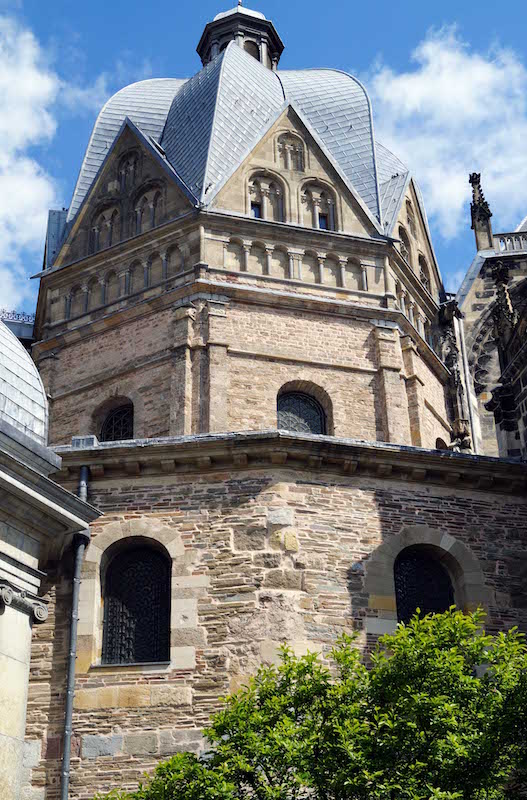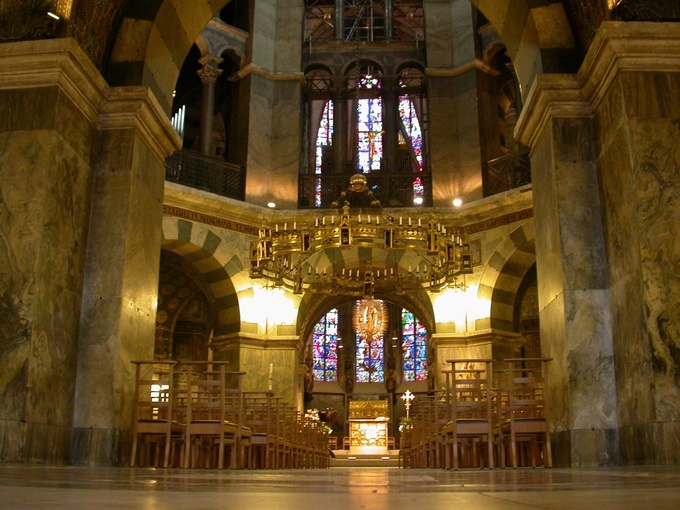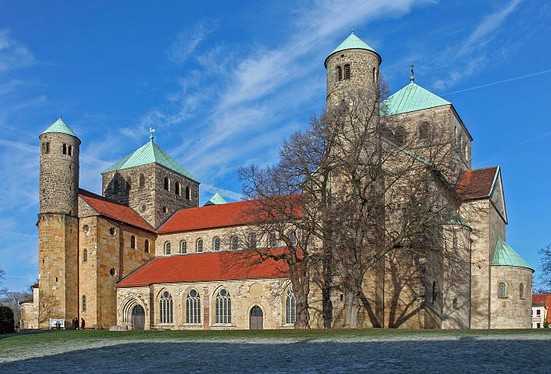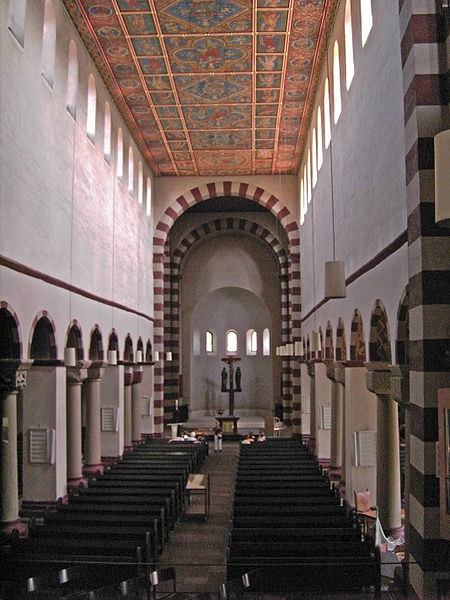The Palatine Chapel at Aachen and St. Michael’s in Hildesheim
The Palatine Chapel at Aachen appears to be a typical example of Carolingian Architecture, while St. Michael’s Church at Hildesheim refers to Ottonian Renaissance. Despite the fact that these constructions were built in different art epochs, there are several similarities between them. The interior of the chapel and the church are rich in arches and columns, which can be noted in Pictures 2 and 4. Both of them have an ambulatory, and their exterior has a complex construction with a variety of forms and windows of different shapes, depicted in Pictures 1 and 3.
Nevertheless, there are numerous differences between Palatine Chapel and St. Michael’s Church, which may be explained by the specifics of architect epochs. Concerning the interiors of the constructions, the influence of Byzantine architecture is perceived in Palatine Chapel decorations. It is evident from Pictures 2 and 4, comparing to the church, the chapel is darker and richer in decorations, which include mosaics characteristic of the Carolingian Renaissance. The latter is modest and contains a range of windows, which make it light in combination with white walls. While Palatine Chapel is centrally planned, St. Michel’s is built in accordance with a concept of the square of the transept, which is the unit for the entire church (“Carolingian Painting in the Early European Middle Ages”; Freeman). This may be explained by the development of mathematic science during the reign of Ottonians (“Carolingian Painting in the Early European Middle Ages”). The fact that St. Michael’s has a crypt inside the church also appears a differentiating feature.




Bernward Doors
One of the prominent creations in the Ottonian Renaissance is Bernward Doors, called after the name of their creator. The doors are made of bronze and framed panels, which is similar to ancient Roman creations to some extent. They are devoted to the theological topic and contain scenes from the Gospels on the right side and the Book of Genesis on the left side. The presentation of scenes is organized using the principle of Adam and Christ mirroring each other (“Ottonian Painting in the Early European Middle Ages”). Therefore, it conveys that the death of Christ, which is sacrifice, compensates the sin of Adam.
The left side illustrative estrangement of people from God, which is becoming more significant in the length of time. These scenes include the Creation, the Fall, and Cain’s murder of Abel, and they are depicted in order from top to bottom. As for the right door, it demonstrates the redemptive work of Christ. The order is from bottom to top, which involves the Annunciation and Nativity, the Passion, and the Resurrection (“Ottonian Painting in the Early European Middle Ages”). Therefore, the author adheres to the chronological order of events, though some happenings, which followed each other, are illustrated in one picture. Such a narrative reflects the medieval mindset and world perception.
Charlemagne as the “Father of Europe”
The reign of Charlemagne, from 742 to 814 years, was especially remarkable, as the emperor managed to complete a great mission. He united German peoples in one kingdom and prompted the population to adhere to Christianity. His empire covered a significant part of Western Europe, and for this reason, Charlemagne is occasionally called the ‘Father of Europe’ (“Charlemagne: The Father of Europe”). He spent most of his life in military expeditions pursuing the aim of uniting the German peoples and including new lands in his Empire (“Charlemagne and the Carolingian revival”). In 800, Pope Leo III acclaimed him the emperor of the Romans, which provided him with a special status in Europe. In addition, Charlemagne was a prominent diplomat and could administrate his vast empire successfully.
Another important feature regarding the reign of Charlemagne implied the development of art. he prompted intellectual and cultural development in this kingdom, and this period in the history of art is named Carolingian Renaissance. Covering approximately 780-900 years C. E., it blossomed during Charlemagne’s administration (“Charlemagne and the Carolingian revival”). The emperor promoted the necessity to be educated and literate among people of the church, which made them reading more religious books and learn how to write (“Charlemagne and the Carolingian revival”). He established the Carolingian minuscule, which implied particular writing standards. Even Charlemagne attempted to learn to write and read, making use of every spare minute. The last crucial course of Charlemagne’s activity implies advancing Christianity among the population of his empire (“Charlemagne: The Father of Europe”). He invested significant sums of money in Christian churches and provided protection and support to people serving there. These are the reasons why Charlemagne is often called “the Father of Europe”.
References
“Carolingian Painting in the Early European Middle Ages.” Lumen. n.d. Web.
“Charlemagne and the Carolingian revival.” Khan Academy. n.d. Web.
“Charlemagne: The Father of Europe.” YouTube, uploaded by Biographics, 2019. Web.
Freeman, J. “Palatine Chapel, Aachen.” Khan Academy. n.d. Web.
“Ottonian Painting in the Early European Middle Ages.” Lumen. n.d. Web.